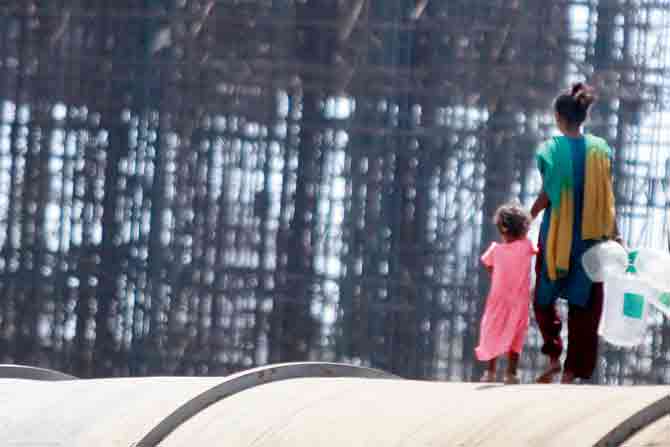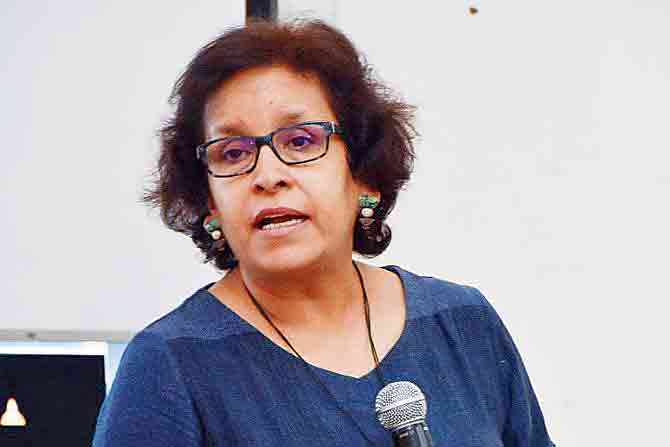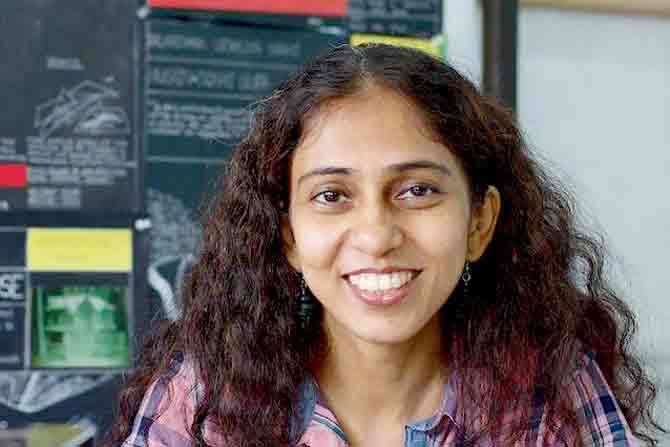A group of architects and urban designers have joined hands with an academic-policy advocate for an unusual project that collects oral and visual records to examine the city-s relationship with its water bodies

A man stands near a shanty house as waves hit the citys waterfront during high tide in June this year. The founders of the Mumbai Water Narratives project say that in the city, the discourse has shifted from water as a resource and commodity, to an entity
In Mumbai, a broken water pipeline also means broken dreams. A July morning in 2017 made this apparent, when a pipeline burst in Bandra East, wreaking havoc in the slum of Indira Gandhi Nagar. Two children—an infant and a nine-year-old—drowned after the water washed away hutments.
Architect-researcher Ipshita Karmakar-s essay, Pipes as a Means to the City, says, "The settlement of Indira Gandhi Nagar was built along the Tansa Pipeline, constructed in 1892. Here, around 5,000 residents had built their households, and at several junctions along the pipeline, siphoned water using subsidiary connections.
ADVERTISEMENT
This was a means of obtaining water in a fairly unequal city, where water flows beneath your feet and yet you are denied access. The flipside of this way of obtaining water is that several times, the weak connections of the pipe have burst, flooding the settlement and washing away property."
The essay is part of Mumbai Water Narratives, a unique project initiated by Living Waters Museum to collect, curate and communicate Mumbai-s rich water heritage.
Launched in July this year, it hopes to engage Mumbaikars, especially children and youth, and help them understand their relationship with water in a city, where such an association is both, inseparable and multi-faceted. From Mumbai-s maritime trade that goes back several centuries, to traditional fishing by Kolis, the imminent problem of flooding and its mesmerising water bodies—sea, lakes, rivers and tanks—the city-s connection with water is commercial, historical, challenging as well as intimate.
Mumbai Water Narratives- online repository, comprising stories, cartographic experiments, drawings, podcasts and personal memories, is an attempt to revisit this relationship, says collaborator Minaz Ansari, professor at the Rizvi College of Architecture, Bandra.

Lack of security means, locals illegally draw water from the Tansa Pipeline. In 2017-18, the houses along it were demolished following a public interest litigation PIL to clear all settlements within 10-metre range. The residents of Indira Gandhi Nagar were shifted to Mahul. PIC/ASHISH RAJE
Living Waters Museum is a virtual museum founded by Sara Ahmed in 2017, to get the youth to visualise water heritage and re-imagine sustainable, inclusive and equitable water futures in the country. An adjunct professor at Ahmedabad University, Ahmed-s "journey with water" began nearly three decades ago, when she was pursuing a PhD in Environmental Sociology from the University of Cambridge. Around the same time, the Indian government launched the first Ganga Action Plan. "[As part of my work], I conducted research in Varanasi, and got interested in the cultural politics of purity and pollution, as well as the livelihoods that were being impacted by the new technologies to clean the river," she shares, in a telephonic interview.
A chance meeting with artist and water activist Basia Irland in Minnesota in early 2000, prompted a conversation around the need for a water museum for India. "As an academic and policy advocate [she is also on the board of WaterAid India], I soon realised that there was a whole lot of -communication- on water happening through the creative arts, which needed our attention." A museum-type approach, she felt, would make the conversations around water more accessible, appealing and less preachy. "But I never saw Living Waters as a museum with four walls. The idea of having something virtual meant that our museum was not tied to one place; we could share notes with other institutions and help young Indians think of perspectives and notions around the right to water, and water justice and equity," says Ahmed.
 Sara Ahmed
Sara Ahmed
Quite early on, Ahmed managed to secure the support of the Global Network of Water Museums—endorsed by UNESCO-s International Hydrology Programme—of which she is a founding member, for her initiative. One of her first projects was spearheaded by a group of photography students of the National Institute of Design NID, Ahmedabad.
Ahmed gave them a quick primer on the water issues in Gujarat. "They came back with amazing stories and memories of water that I had never really thought of, like ship-breaking at Alang, the dhobi ghats along the Sabarmati river and the salt workers in the Rann of Kutch. They were creative students doing their Masters in Photography, and here I was making them think about water. So, that-s really the kind of footprint we want to have—interdisciplinary and inclusive."
Since then, the virtual museum, which is based at the Centre for Heritage Management, Ahmedabad University, has harnessed the power of music, song, film, photography, prose and poetry to tell water stories. In March, the Living Waters team also showcased the first prototype of its interactive map on the famous vav or stepwells of Ahmedabad.

Wells like this one in Chembur gaothan have a strong cultural connect with the communities. PIC COURTESY/ Mohammed Esa Shaikh
The Mumbai project was launched when Karmakar reached out to Ahmed, during the lockdown. Ahmed thought it was the right time to document her birth city-s water heritage. Ansari and architects Jinisha Lodaya and Nisha Nair-Gupta joined the team.
The discourse in Mumbai has shifted from water as a resource, water as philanthropy 1800s, water as a civic property 1845 onwards, water as a commodity, to water as a right for citizens since 2014, and also an entity that can ravage homes every monsoon, say the founders. The changing nature of the relationship of the city with water, made it doubly important to identify these narratives.
As a starting point, the team has been using its Instagram handle @mumbaiwaternarratives, to call for entries, both oral and visual. "We are looking at everything from architecture to stories that discuss livelihoods [like those of the bishtis or water carriers, Kolis and dhobis], which are closely linked to water, and customs and practices where water still plays a significant role," says Ansari. The Instagram feed currently has personal memories and photographs of contributors, who-ve witnessed the "chaos of Bhaucha Dhakka," the surreal sight of the migratory flamingos, and the peace of Banganga Tank. Then, there-s also the manner in which water is stored in large drums and buckets outside tenements—a grim reminder of the disparity in distribution of water in the city. "This collection sets a narrative of how a plastic blue barrel, as essential furniture, becomes a part of many households…" the caption reads.
The website, on the other hand, offers a more serious, in-depth investigation into the city-s water heritage—the quaint fountains, pyaavs, and pipelines among them. It-s still a work in progress, admits Ansari, who has personally researched Mumbai-s wells for the initiative.

A file picture of a pre-wedding East Indian ceremony. The bridesmaids seen leaving for the well. PIC COURTESY/Padmini Chakravarti nee Quinny
The wells have a strong cultural connect within different communities. The legends and histories surrounding them only make them more fascinating objects of history. Bhikha Behram Well, a Grade 1 heritage structure located near Cross Maidan, is one such example. It was built by Bhikhaji Behram, a trader from Baruch, and opened to public in the year 1728. "The most popular legend is about how the trader was imprisoned due to mistaken identity as a Mughal spy and once released, built this as a token of gratitude. As per local stories, during the great fire at the naval docks in 1944, this well provided water day and night for over a week to help the fire tenders douse the flames," says Ansari.
Another intriguing story around Zoroastrian wells includes two prominent agiaries—the Anjuman Parsee Agiary and the Wadia Agiary—both in close proximity at Princess Street, which was relayed by archaeologist Kurush F Dalal during a lecture. "The well in each agiary is home to a turtle, with a patch each on their left and right sides, respectively. According to local legend, the patch is known to interchange sides during different times of the year, indicating that the turtles in fact travel between wells probably through an underground aquifer that connects them. Separated by urban development in the visible plain, these wells however, follow their own natural networks below ground level," adds Ansari.

Minaz Ansari
Some of the wells that have survived, especially those in the Christian villages, are used by East Indians for their wedding ceremonies. The wells were usually situated next to a fig tree. "Even today, families of the to-be-weds make offerings to the well, after which water is drawn from it, to bathe the bride and groom a day before the wedding," says Ansari of the tradition, known as Umbracha Pani.
The team is also hoping to source stories from the Warli Adivasi community, which lives in and around Sanjay Gandhi National Park in Borivli and Aarey Colony. "They are the true custodians of the river. They have a very inter-dependent relationship with it; they use the river for domestic purpose, and ensure that it is never polluted. At the point that this river exits the national park, it becomes a nullah. There is a stark difference between how we and the indigenous communities treat our rivers."
 This picture represents the stark disparity in water distribution. For most tenements, blue drums are now part of standard furniture. PIC COURTESY/Sidnyaam Frames, Mumbai Water Narratives
This picture represents the stark disparity in water distribution. For most tenements, blue drums are now part of standard furniture. PIC COURTESY/Sidnyaam Frames, Mumbai Water Narratives
The project will translate into a virtual exhibition next year on March 22, observed as World Water Day. "In the meanwhile, we hope to hold pop-up exhibitions and heritage and river walks to create awareness about these stories," says Ansari.
Keep scrolling to read more news
Catch up on all the latest Mumbai news, crime news, current affairs, and a complete guide from food to things to do and events across Mumbai. Also download the new mid-day Android and iOS apps to get latest updates.
Mid-Day is now on Telegram. Click here to join our channel @middayinfomedialtd and stay updated with the latest news
 Subscribe today by clicking the link and stay updated with the latest news!" Click here!
Subscribe today by clicking the link and stay updated with the latest news!" Click here!







